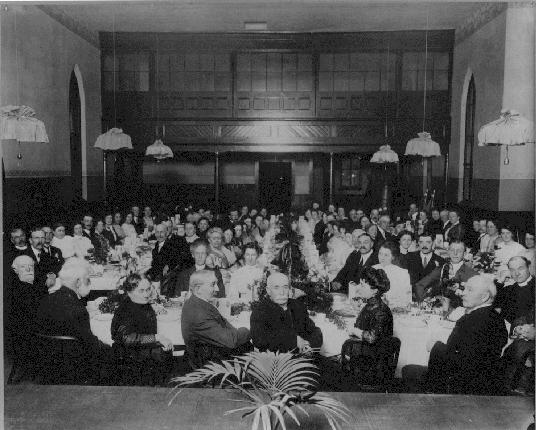 Banquet at St. Andrew's Circa 1900
Banquet at St. Andrew's Circa 1900
The first Presbyterian Church on the West Coast of North America was established in 1838 in Oregon. Further north, the Hudson's Bay Company ran the colony of Vancouver Island. An Anglican Church was supported because of the Hudson's Bay Company's English Anglican background despite the many Scottish Presbyterians in employment. It was not until 1861 the Irish Presbyterians sent Reverend John Hall to Victoria where he firmly established the Presbyterian Church. (Kirk 10)
The work by some Church members affected the look of the young city of Victoria. Otto TiedemannMr Tiedemann was a prominent Victorian architect designed the city's first parliament buildings and Robert Burns McMicking brought the innovations of telephones and electric lights to Victoria. (Kirk 56) Many businessmen such as R.P. RithetMr. Rithet was one of the wealthiest residents of BC and Robert DunsmuirWas an early but inconsistent member of St Andrew's and a coal mine founder. also held political provincial appointments, as did Robson who worked for years as a newspaper editor and later became the province's Premier. (Kirk 50) Even a member with a career in medicine, Dr. G. L. Milne, became a member of the provincial legislature. (Kirk 58) The trend of Church members being active in politics fits author Harold Falding's assertion that Presbyterians in Canada had an activist understanding of religion which included political expression. (Falding 159)
With its political and business interconnections in Victoria, the congregation likely proved to be a useful networking and social hub for its members. Evidence of networking is evident during the early 1980s depression when Rithet hired Alexander Gray to work as manager for one of his businesses. A second example of interconnectedness occurred when Joseph HunterJoseph Hunter was a surveyor, son in law of Mr. Robson and politician in Victoria married Fannie Robson and later became the Chief Engineer of the E & N Railway owned by Dunsmuir.
A look at statistics shows that twenty years later, in 1881, the majority of St. Andrew's congregation was born in Scotland. By the end of the Victorian era, however, the majority was Canadian born. Some members were even Chinese, evidence that the Church's Chinese missionary work had achieved some success.
Another shift occurred with the age groups that dominated the pews. At the beginning of the period 40-60 year olds were the majority but by the end of the era the largest group was 30-39 year olds. This shift towards younger members, particularly those with young families, boded well for the vitality of the Church.
A consistent trend throughout the period was that women made up over half of the members listed on Church Rolls. Women were key fundraisers for the Church with the Church's Ladies Aid Society headed by Mrs. Robson.
Sources:
Mainline Protestantism in Canada and the United States of America: An Overview, Harold Fallding, the Canadian Journal of Sociology, vol. 3, No. 2 (Spring, 1978), pp. 141-160
The Kirk That Faith BuiltThe Kirk That Faith Built: St. Andrew's on Douglas Street, 1890-1990. Published by the Session of St. Andrew's Presbyterian Church. Morriss Printing Company, Victoria, 1989.
